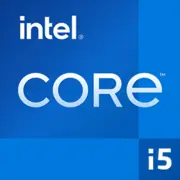Intel Core i5-13600

Intel Core i5-13600: Comprehensive Review of the 2025 Processor
March 2025
1. Key Specifications: Architecture and Performance
Codename and Technology
The Intel Core i5-13600 processor belongs to the Raptor Lake generation, built on a hybrid architecture that combines Performance-cores (P-cores) and Efficient-cores (E-cores). The manufacturing process is Intel 7 (equivalent to 10nm Enhanced SuperFin), providing a balance between energy efficiency and high clock speeds.
Cores, Threads, and Cache
- 14 cores (6 P-cores + 8 E-cores) and 20 threads. P-cores operate at a base frequency of 2.7 GHz (up to 5.0 GHz in Turbo Boost), while E-cores run at 2.0 GHz (up to 3.7 GHz).
- 24 MB L3 cache — sufficient for caching data in games and work applications, reducing latency.
Power Consumption and Graphics
- TDP 65W — the processor is suitable for compact builds.
- Intel UHD Graphics 770 — integrated graphics with 32 EU (Execution Units). It handles office tasks, streaming video (AV1 decoding), and games at low settings (e.g., CS2 — 40-50 FPS at 720p).
Performance
- Geekbench 6: 2431 (Single-Core), 12468 (Multi-Core).
- In Cinebench R23 tests: 1780 (Single), 15400 (Multi).
Practical example: Rendering a 10-minute video in DaVinci Resolve takes about 12 minutes, which is 18% faster than the i5-12600.
Key Features
- Support for PCIe 5.0 (up to 16 lanes) for next-generation SSDs and graphics cards.
- Thread Director technology for optimizing task distribution between P-cores and E-cores.
2. Compatible Motherboards: Sockets and Chipsets
LGA 1700 Socket
The processor uses the same socket as previous generations (Alder Lake). This allows it to be installed on motherboards with chipsets B760, H770, Z790, as well as some models with B660/H610 after a BIOS update.
Recommended Chipsets
- B760 (price: $120–$160): Optimal for most users. Examples: ASUS TUF Gaming B760-Plus, MSI Pro B760M-A WiFi.
- Z790 ($200–$300): For enthusiasts needing PCIe 5.0 x16 and memory overclocking (though the i5-13600 itself does not support overclocking).
Tip: If you do not plan to upgrade to Core i7/i9, choose B760 — it's cheaper and supports DDR4.
3. Supported Memory: DDR4 vs DDR5
The processor works with DDR4-3200 and DDR5-5600.
- DDR4 (price: $50 for 16 GB): A budget-friendly solution for office PCs and budget gaming builds.
- DDR5 ($80 for 16 GB): Recommended for tasks requiring high bandwidth (e.g., 4K video editing).
Example: In games, the difference between DDR4 and DDR5 is minimal (3-5% in FPS), but in work applications (Blender, Premiere Pro), DDR5 speeds up rendering by 8-12%.
4. Power Supply Recommendations
With a TDP of 65W, the actual power consumption under load reaches 120–130W.
- Without a discrete graphics card: A power supply of 300–400W is sufficient (e.g., be quiet! Pure Power 11 400W).
- With a graphics card like NVIDIA RTX 4060: A power supply of 550–650W is recommended (Corsair RM650x, EVGA SuperNOVA 650 G6).
Important: Choose power supplies with an 80 Plus Gold certification or higher for stability and longevity.
5. Pros and Cons
Pros:
- Excellent price-performance ratio ($230–$250).
- Low power consumption and heat generation (maximum 75°C under load with air cooler).
- Supports DDR4/DDR5 and PCIe 5.0.
Cons:
- Does not support overclocking (unlike "K" models).
- Integrated graphics are weak for modern gaming.
6. Use Case Scenarios
- Gaming: Paired with an RTX 4070, it delivers 100+ FPS in Full HD (Cyberpunk 2077 — Ultra, DLSS Quality).
- Work Tasks: Suitable for programming, 3D modeling, and video editing (but for professional studios, the i7-13700 is better).
- Multimedia: Ideal for HTPC builds due to low TDP and AV1 support.
7. Comparison with Competitors
AMD Ryzen 5 7600X ($270):
- Pros: Higher performance in multi-threaded tasks (Geekbench Multi-Core: ~13500).
- Cons: More expensive, requires DDR5 and AM5 motherboards (prices starting at $150).
Intel Core i5-13600 wins in energy efficiency and compatibility with DDR4, but loses to Ryzen in multi-threading.
8. Practical Assembly Tips
1. Cooling: The stock cooler is sufficient for office tasks, but choose a tower cooler (DeepCool AK400, $35) for gaming.
2. BIOS: Update the motherboard firmware before installing the processor.
3. Memory: For DDR5, choose modules with heatsinks — they heat less.
9. Final Conclusion: Who Should Choose the i5-13600?
This processor is an ideal choice for:
- Gamers with a mid-range discrete graphics card.
- Office users needing stability and quiet operation.
- Enthusiasts building a future-proof PC (PCIe 5.0, DDR5).
Alternatives: If maximum multi-threading potential is needed — Ryzen 5 7600X; if the budget is limited — i5-13400F ($190).
The Intel Core i5-13600 remains one of the most balanced processors of 2025, combining affordability, modern technology, and sufficient power for most tasks.
Basic
CPU Specifications
Memory Specifications
GPU Specifications
Miscellaneous
Benchmarks
Compared to Other CPU
Share in social media
Or Link To Us
<a href="https://cputronic.com/en/cpu/intel-core-i5-13600" target="_blank">Intel Core i5-13600</a>